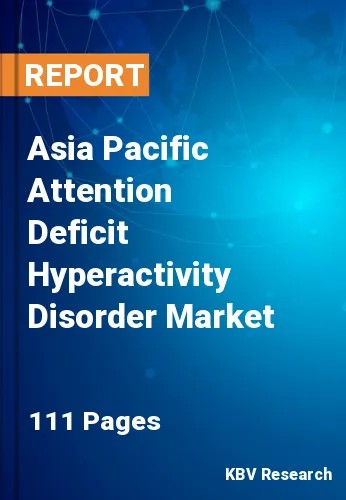The Asia Pacific Attention Deficit Hyperactivity Disorder Market would witness market growth of 5.6% CAGR during the forecast period (2022-2028).
Studies using magnetic resonance imaging (MRI) reveal more significant cortical thinning and reduced volumes of the caudate, cerebellum, corpus callosum, and suitable frontal regions. Functional MRI results, including some studies of drug-naive patients, reveal distinctions in the functioning of the brain between controls and those with ADHD.
Adults with ADHD have impaired cerebral glucose metabolism in the premotor and prefrontal regions of the frontal lobe, according to positron emission tomography (PET). The immediate and noticeable reaction of ADHD signs to stimulant drugs like methylphenidate and amphetamines, which raise synaptic dopamine levels, raises the possibility that deficits in dopaminergic, catecholaminergic, and nicotinergic functioning are the primary underlying pathophysiological process.
Due to the widespread effects of ADHD, the condition is likely to have an adverse economic impact on kids, families, and society as a whole. The study of these financial implications has only recently begun, but preliminary research indicates that ADHD raises healthcare and other costs. A number of research studies have looked at the costs to families, the cost of criminal behavior among people with ADHD, the cost of prevalent medical and psychiatric comorbidities of ADHD.
In recent years, a rise in the number of individuals with ADHD has been observed in China. It has been estimated by extrapolating the data from several studies that the number of ADHD patients would increase further. The increased ADHD among school-aged children is also associated with mounting academic pressure. As a result of the increasing recognition of ADHD in the nation, many parents and teachers have reported a higher number of children with ADHD than there are. Additionally, in this region, it has also been seen that the prevalence of ADHD was higher in children belonging to low socioeconomic status backgrounds.
The China market dominated the Asia Pacific Attention Deficit Hyperactivity Disorder Market by Country in 2021; thereby, achieving a market value of $816.5 million by 2028. The Japan market is registering a CAGR of 4.9% during (2022 - 2028). Additionally, The India market would showcase a CAGR of 6.2% during (2022 - 2028).
Based on Drug Type, the market is segmented into Stimulants and Non-stimulants. Based on Stimulants Type, the market is segmented into Amphetamine, Methylphenidate, Lisdexamfetamine and Dexmethylphenidate. Based on Non-stimulants Type, the market is segmented into Atomoxetine, Guanfacine, Clonidine and Others. Based on Demographics, the market is segmented into Adults and Children. Based on Distribution Channel, the market is segmented into Retail Pharmacy and Hospital Pharmacy. Based on countries, the market is segmented into China, Japan, India, South Korea, Singapore, Malaysia, and Rest of Asia Pacific.
Free Valuable Insights: The Worldwide Attention Deficit Hyperactivity Disorder Market is Projected to reach USD 16.9 Billion by 2028, at a CAGR of 4%
The market research report covers the analysis of key stake holders of the market. Key companies profiled in the report include Eli Lilly And Company, Pfizer, Inc. (Global Blood Therapeutics, Inc.), Johnson & Johnson (Johnson & Johnson Services, Inc.), Lupin Limited, Novartis AG, Takeda Pharmaceutical Company Limited, Mallinckrodt PLC, Purdue Pharma L.P., Aytu BioPharma, Inc. and Supernus Pharmaceuticals, Inc.
By Drug Type
By Demographics
By Distribution Channel
By Country
Our team of dedicated experts can provide you with attractive expansion opportunities for your business.

